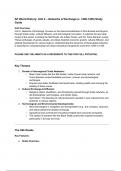AP World History: Unit 2 – Networks of Exchange (c. 1200-1450) Study
Guide
Unit Overview:
Unit 2, Networks of Exchange, focuses on the interconnectedness of Afro-Eurasia and beyond
through trade routes, cultural diffusion, and technological innovation. It explores the key trade
routes of the period, including the Silk Roads, the Indian Ocean, and the Trans-Saharan routes.
These exchanges of goods, people, and ideas fostered economic growth, cultural diffusion, and
political development in various regions. Understanding the dynamics of these global networks
is essential for comprehending how these interactions shaped the world from 1200 to 1450.
PLEASE USE THE AMSCO AS A REFERENCE TO THIS FOR FULL POTENTIAL
Key Themes
1. Growth of Interregional Trade Networks:
○ Major trade routes like the Silk Roads, Indian Ocean trade network, and
Trans-Saharan routes facilitated economic, cultural, and technological
exchanges.
○ Empires and states facilitated and taxed trade, building wealth and ensuring the
stability of these routes.
2. Cultural Exchange & Diffusion:
○ Religions (Islam, Buddhism, and Christianity) spread through trade networks, as
did philosophies, technologies, and artistic styles.
○ Syncretism: The blending of cultural elements resulted in new cultural forms and
practices in various regions.
3. Technological and Environmental Developments:
○ New technologies in navigation and transportation (e.g., the compass, caravans,
and ships) allowed for greater exchange.
○ Agricultural and commercial innovations helped drive economic prosperity.
○ The spread of diseases like the Black Death profoundly impacted societies,
particularly in Europe and Asia.
The Silk Roads
Key Features:
● Route Overview:
, ○ The Silk Roads connected China to the Mediterranean, facilitating the exchange
of luxury goods such as silk, spices, tea, and porcelain.
○ Major trading cities like Kashgar, Samarkand, and Baghdad served as hubs for
the transfer of goods, culture, and ideas.
● Political & Economic Impact:
○ The Mongol Empire (1206-1368) revitalized the Silk Roads by providing
protection and stability across a vast portion of Eurasia.
○ Commercial innovations like paper money and bills of exchange made
long-distance trade more efficient.
○ Empires such as the Yuan dynasty in China and the Abbasid Caliphate
prospered by taxing and controlling sections of the Silk Roads.
● Cultural & Technological Diffusion:
○ Buddhism spread from India to China, Korea, and Japan via the Silk Roads,
blending with local beliefs (e.g., Zen Buddhism in Japan).
○ Technologies like gunpowder, the printing press, and paper traveled westward
from China to Europe.
○ Islam expanded eastward along the trade routes, becoming a dominant religion
in Central Asia and parts of Southeast Asia.
Important Cities Along the Silk Roads:
● Kashgar: A key city in Central Asia that connected traders from China, the Middle East,
and Europe.
● Samarkand: A thriving city on the Silk Roads, known for its markets and as a center of
Islamic learning.
● Baghdad: A center of culture, trade, and learning during the Abbasid Caliphate,
connecting Europe, Africa, and Asia.
Key Goods Traded:
● From East Asia: Silk, tea, porcelain, paper.
● From South Asia: Spices, textiles, precious stones.
● From the Middle East: Carpets, dates, glass, horses.
● From Europe: Wool, linen, silver, wine.
Indian Ocean Trade Network
Key Features:
● Route Overview:
○ The Indian Ocean trade network connected East Africa, the Arabian Peninsula,
South Asia, and Southeast Asia.




